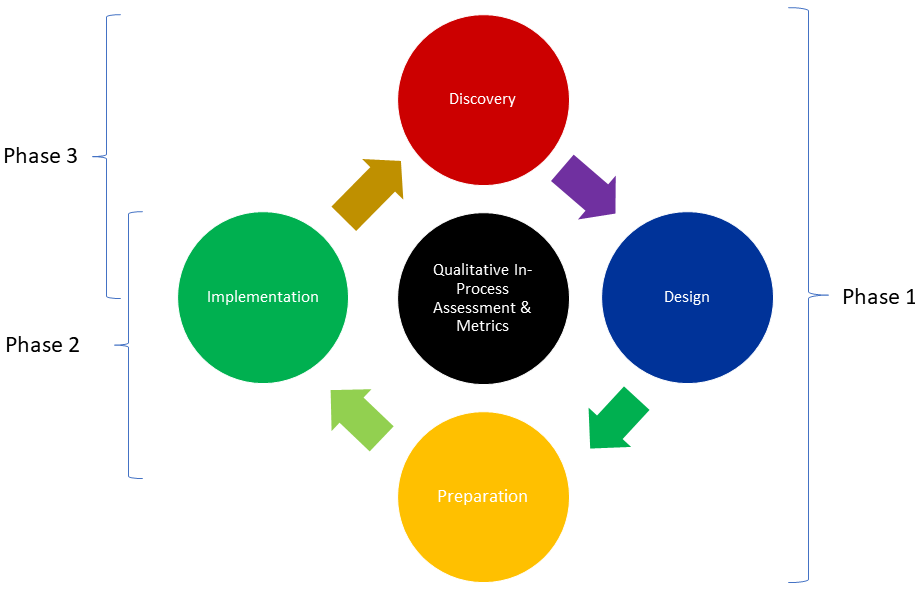What is Mosaic Methods?
Mosaic Methods, is an integrative set of strength-based tools and practices built upon a collective inquiry as to what the best attributes of an organization or community have been and how to inclusively build upon those positive attributes.
The need and applicability for change practices through a positive and appreciative lens has never been stronger. Yet, taking tangible actions to leverage the strengths, capital and diversities of people is still not a common practice. Mosaic Methods can be a key step in bringing people together for this goal as it is intentionally designed for the collaborative alignment of stakeholders and resources.
Within organizations, common applications of Mosaic Methods are: culture change and adaptability, team development and alignment, strategic planning or building a high-performing operation. Within communities, application can take the form of bringing cross-sector leadership to impact workforce development or cultivating bonds and cohesion across often polarized differences which may be cross-cultural, inter-racial, inter-faith or political affiliation. Thus the focus of the collection of Mosaic Methods is on innovation through inclusion and the development of capital through accelerating the formation of strong ties between people.
Phases
Mosaic Methods consists of five strategic phases (Awareness-Alignment-Engagement-Expansion-Re-Engagement), each of which have unique approaches and quantifiable outcomes. The earlier phases of Awareness and Alignment are based more in discovering what relationships, behaviors and values give life to a group stimulating the growth of trust and social capital. The phases are customizable and complementary so as to integrate with agendas already underway. More information on the phases available below:
Awareness – Alignment
The model begins with Awareness and Alignment as phases in the form of a community-based inquiry of what outcomes, behaviors and goals need to be achieved? What is the best of what we’ve achieved in the past? How did it make us feel? How do we attain more of it? Awareness and Alignment phases can include appreciative peer to peer interviews, stakeholder gatherings as well as strength-based assessments that makes visible the diversities of an individual’s thoughts and approaches to action. Outcomes from Awareness and Alignment may serve as context and topics for later phase.
Engagement
The next phase of the Mosaic Methods model engages participants by creating the opportunity and process for participants and groups to have inclusive constructivist dialogues as they develop resilient integrative relationships that are much too infrequent in our organizations and communities. While Awareness and Alignment conversations continue to happen all the time, a mechanism for structured engagement which we call Mosaic Partnerships may be put in place to build trust and empathy, embrace challenging conversations, encourage inclusion through bridging and increase the likelihood of networks of individuals orienting around a common goals. The intention of Mosaic Partnerships is to have communities and institutions learn the process and take ownership of it as yet another mechanism for innovation. There is more information about Mosaic Partnerships available here.
Re-Engagement
Expansion and Re-Engagement are phases of Mosaic Methods which come directly out of the principles of strong community-building. A structured engagement does not occur to create an expertise about others or for the sake of acquiring knowledge alone; the goal is to acquire subjective context being able to think about solutions in both targeted and universal ways. For this reason, Expansion and Re-Engagement emphasizes principles such as resource collaboration and the understanding that there is a need to constantly revisit community, stakeholders and partners to grow inclusively. Additionally, we offer courses and trainings for the continued development of individuals, groups and institutions as the work of innovation and inclusion continues. Expansion and Re-Engagement will find individuals and groups becoming more interpersonally and inter-culturally competent dealing with differences and commonalities with increased complexity.
Mosaic Methods
Powered by
Odyssey of Humanity
693 East Avenue, Rochester, NY 14607
585-442-4110
info@odysseyofhumanity.org
Odyssey for Humanity is a Not-for-Profit 501(c)(3). ©2016 Odyssey of Humanity, Inc. All rights reserved.
Powered by
Odyssey of Humanity
693 East Avenue, Rochester, NY 14607
585-442-4110
info@odysseyofhumanity.org
Odyssey for Humanity is a Not-for-Profit 501(c)(3). ©2016 Odyssey of Humanity, Inc. All rights reserved.

